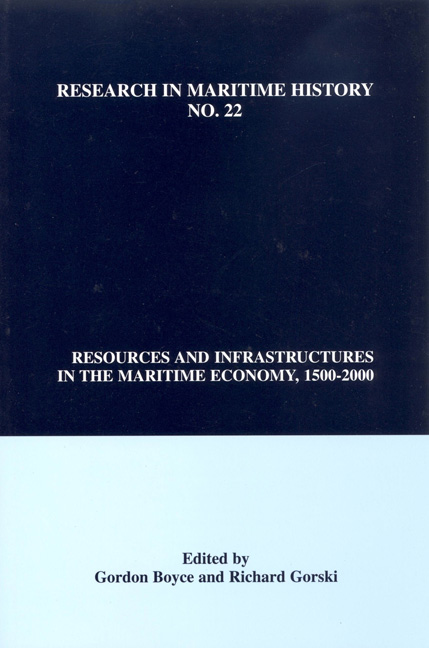Book contents
- Frontmatter
- Contents
- Contributors' Notes
- “Introduction: Resource Flows and Maritime Infrastructures”
- Part 1 Intangible Infrastructures and their Components
- Part 2 Resource Flows and Economic Development
- “Resources and Infrastructures in the Danish Maritime Economy: Evidence for the Coastal Zone, 1500-2000”
- “Resources and Infrastructures in the Maritime Economy of Southwest Scotland, 1750-1850”
- “Fishing Rights in the Postwar Period: The Case of North Sea Herring”
- Part 3 Physical Infrastructures: Port Development and Planning
“Resources and Infrastructures in the Danish Maritime Economy: Evidence for the Coastal Zone, 1500-2000”
from Part 2 - Resource Flows and Economic Development
- Frontmatter
- Contents
- Contributors' Notes
- “Introduction: Resource Flows and Maritime Infrastructures”
- Part 1 Intangible Infrastructures and their Components
- Part 2 Resource Flows and Economic Development
- “Resources and Infrastructures in the Danish Maritime Economy: Evidence for the Coastal Zone, 1500-2000”
- “Resources and Infrastructures in the Maritime Economy of Southwest Scotland, 1750-1850”
- “Fishing Rights in the Postwar Period: The Case of North Sea Herring”
- Part 3 Physical Infrastructures: Port Development and Planning
Summary
Historians of the Danish economy usually emphasise the importance of agriculture since Neolithic times. Evidence put forward in this paper suggests that a revision of this perception is necessary. The maritime component of the economy dominated medieval exports, and while the seventeenth century was marked by a decline in maritime activities, the eighteenth century was associated with a resurgence of shipping in particular. This overview looks first at natural resources, population and business statistics, and then goes on to present an historical overview on the development of the main maritime industries, fisheries and shipping, as well as other coastal economic activities in order to understand the relationship between settlement and economic activity. The outcome of this research is a fuller picture of the maritime population and activities of Denmark between 1500 and 2000.
Natural Resources
Growth in Danish coastal regions, especially from the late Middle Ages, took place on four distinct types of land: heaths, woods, cornfields and meadows. The heaths and meadows were characteristic of the coastal landscape of Jutland from the Kattegat up to the Limfjord, and the same landscapes were also a feature of the two Kattegat islands, Laes0 and Anholt (see figure 1). Seventeenth-century woodland clearances opened up the landscape, leaving it bare, with grazing by sheep and cattle keeping down the growth of vegetation. It was a landscape that could only be inhabited by drawing on all of the many resources and opportunities offered by the coast, in contrast to the specialised cultivation of corn found in the inland areas. Sand dunes dominated the North Sea coastline, which made even harsher demands on an already frugal existence and heightened the need to maintain pluralistic subsistence strategies. In contrast, the Limfjord and the fjords of east Jutland were characterised by fields rich with corn and lush acres of meadowland. This contrast created contrasting social interactions between two completely different worlds.
The central landscape of the cornfields lay in southern Denmark, namely in south Jutland and on the Danish isles. The soil in much of this region was moraine clay, which stretched right out to the coast, creating a landscape that reflected its predominant function as farmland. Even so, there were tracts of land, as in north Sealand, on the small islands in southern Denmark, and on Bornholm, where fishing and shipping played important roles.
- Type
- Chapter
- Information
- Publisher: Liverpool University PressPrint publication year: 2002



